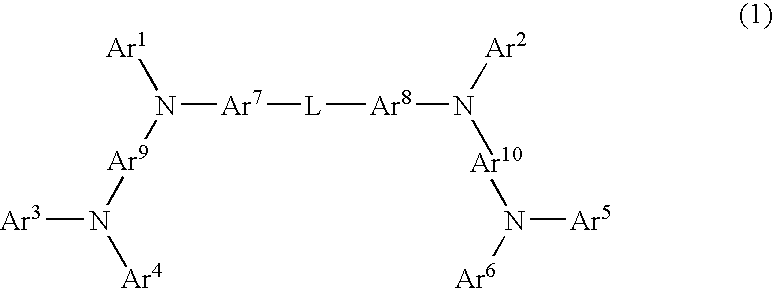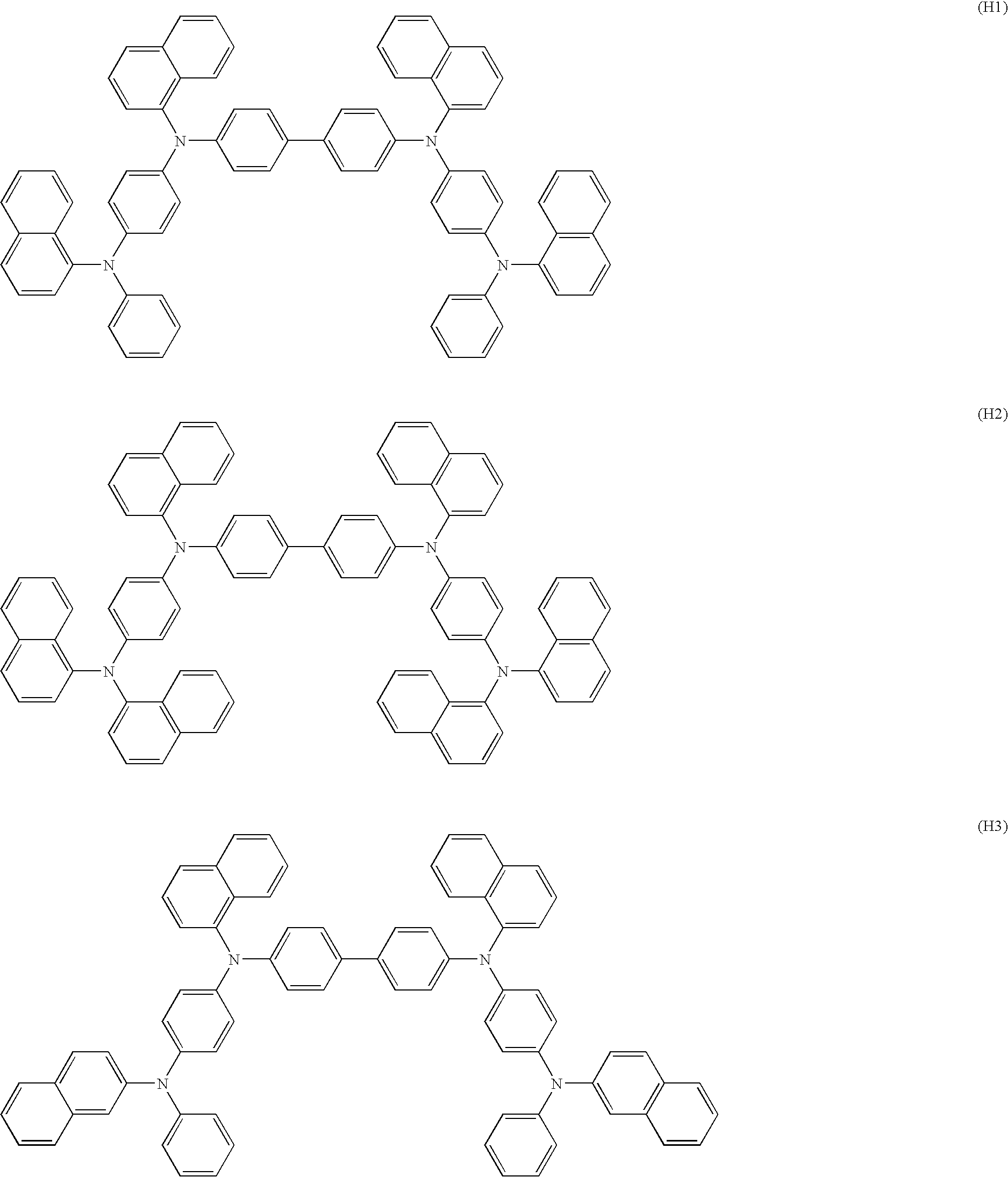Aromatic amine derivative and organic electroluminescent element employing the same
a technology of organic electroluminescent elements and amine derivatives, which is applied in the direction of discharge tubes/lamp details, discharge tubes luminescent screens, organic chemistry, etc., can solve the problems of not having satisfactory heat resistance and unsuitable for on-vehicle uses to which a heat resistance is required, and achieves high luminous efficiency
- Summary
- Abstract
- Description
- Claims
- Application Information
AI Technical Summary
Benefits of technology
Problems solved by technology
Method used
Image
Examples
synthetic example 1
Synthesis of 2-iodonaphthalene
[0108] A small amount of iodine (manufactured by Tokyo Kasei Kogyo Co., Ltd.) was added to 14 g of magnesium having a shaved form (manufactured by Tokyo Kasei Kogyo Co., Ltd.) and 230 ml of THF which was dried and distilled while heating at 50° C. and stirring to activate magnesium, and then a solution prepared by dissolving 105 g of 2-bromonaphthalene (manufactured by Tokyo Kasei Kogyo Co., Ltd.) in one liter of THF which was dried and distilled was dropwise added thereto in one hour.
[0109] After finishing dropwise adding, the solution was stirred at 50° C. for 2 hours and cooled down to −10° C., and then 250 g of iodine was added little by little. The temperature was returned to a room temperature, and then stirring was continued for 2 hours.
[0110] Water 100 ml was added to the above reaction liquid, and it was extracted with ethyl acetate. The ethyl acetate layer was extracted with a caustic soda aqueous solution, and after the aqueous layer was w...
synthetic example 2
Synthesis of 9-iodophenanthrene
[0111] A small amount of iodine (manufactured by Tokyo Kasei Kogyo Co., Ltd.) was added to 14 g of magnesium having a shaved form (manufactured by Tokyo Kasei Kogyo Co., Ltd.) and 230 ml of THF which was dried and distilled while heating at 50° C. and stirring to activate magnesium, and then a solution prepared by dissolving 129 g of 9-bromophenanthrene (manufactured by Tokyo Kasei Kogyo Co., Ltd.) in one liter of THF which was dried and distilled was dropwise added thereto in one hour.
[0112] After finishing dropwise adding, the solution was stirred at 50° C. for 2 hours and cooled down to −10° C., and then 250 g of iodine was added little by little. The temperature was returned to a room temperature, and then stirring was continued for 2 hours.
[0113] Water 100 ml was added to the above reaction liquid, and it was extracted with ethyl acetate. The ethyl acetate layer was extracted with a caustic soda aqueous solution, and after the aqueous layer was...
synthetic example 3
Synthesis of N,N′-bis(naphtho-1-yl)-4,4′-benzidine (A1)
[0114] Mixed under argon flow were 100 g of N,N′-diacetyl-4,4′-benzidine (manufactured by Tokyo Kasei Kogyo Co., Ltd.), 282 g of 1-iodonaphthalene (manufactured by Tokyo Kasei Kogyo Co., Ltd.), 204 g of anhydrous potassium carbonate (manufactured by Tokyo Kasei Kogyo Co., Ltd.), 4.7 g of copper powder (manufactured by Hiroshima Wako Co., Ltd.) and 750 ml of decalin, and they were reacted at 190° C. for 3 days.
[0115] After cooling, 2 liter of toluene was added thereto to filter an insoluble matter. The matter filtered was dissolved in 4.5 liter of chloroform to filter off an insoluble matter, and then the filtrate was treated with activated carbon and concentrated under reduced pressure. Acetone 3 litter was added when the solution became slurry in the middle of concentration, and crystal precipitated was filtered and dried.
[0116] This was suspended in a mixture of 2 liter of ethylene glycol and 20 ml of water, and 110 g of a ...
PUM
| Property | Measurement | Unit |
|---|---|---|
| heat resistance | aaaaa | aaaaa |
| work function | aaaaa | aaaaa |
| thickness | aaaaa | aaaaa |
Abstract
Description
Claims
Application Information
 Login to View More
Login to View More - R&D
- Intellectual Property
- Life Sciences
- Materials
- Tech Scout
- Unparalleled Data Quality
- Higher Quality Content
- 60% Fewer Hallucinations
Browse by: Latest US Patents, China's latest patents, Technical Efficacy Thesaurus, Application Domain, Technology Topic, Popular Technical Reports.
© 2025 PatSnap. All rights reserved.Legal|Privacy policy|Modern Slavery Act Transparency Statement|Sitemap|About US| Contact US: help@patsnap.com



